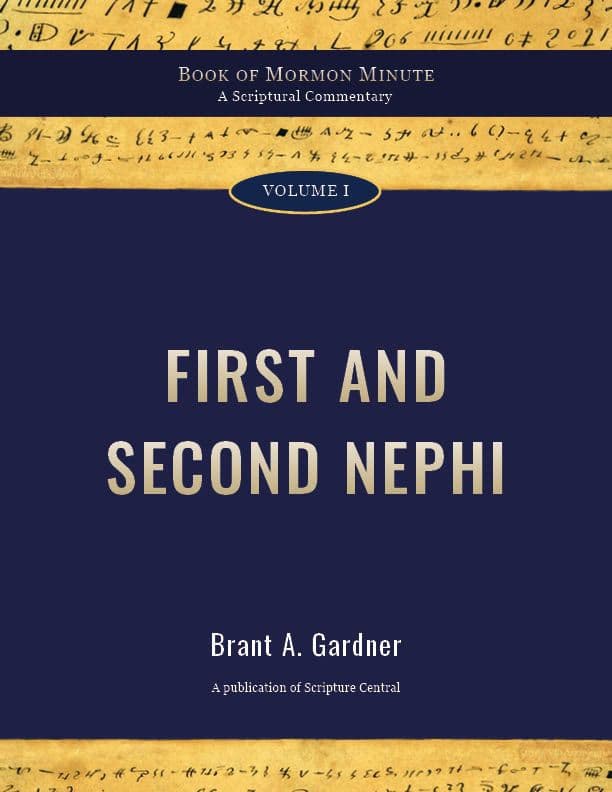Book
55 Chapters

1 And all these things did my father see, and hear, and speak, as he dwelt in a tent, in the valley of Lemuel, and also a great many more things, which cannot be written upon these plates.
2 And now, as I have spoken concerning these plates, behold they are not the plates upon which I make a full account of the history of my people; for the plates upon which I make a full account of my people I have given the name of Nephi; wherefore, they are called the plates of Nephi, after mine own name; and these plates also are called the plates of Nephi.
The first verse is Nephi’s ending of the story of the dream. We get his segment-ending phrase “dwelt in a tent.” As with other times when Nephi speaks of his father’s tent, or his father dwelling in a tent, the function is to separate sections of the story being told in the larger chapter. What is most important in this case is that Nephi makes mention that many other things happened “which cannot be written upon these plates.”
That phrase obviously mentions plates, and apparently it finally occurs to Nephi that he hasn’t explained to his readers the various plate records he is working with. This creates an aside. Nephi moves out of his role as the narrator of history and into his role as the writer of history. He speaks of his process. He will do this a total of three times. The first (being this one) and the second are both insertions by Nephi the writer into the narrative story. Finally, the third time will be a short explanation of creating the plates in the narrative timeline that actually produced them.
Nephi notes that there are two sets of plates. He has made both sets by hand (though that is not mentioned here), and he is (at that time) the only writer on both sets of plates. He also explains that each is called “the plates of Nephi.” The designation of the small plates of Nephi to refer to this current set comes from Jacob 1:1, where Jacob describes them as “the small plates, upon which these things are engraven.” The term “large plates of Nephi” is derived as a counter to the small plates.
Since Nephi made both sets, it is probable that he made them all the same size. Since the plates of brass were so important to him, it is also possible that their size, and perhaps even color, influenced the size and materials for the plates Nephi made.
3 Nevertheless, I have received a commandment of the Lord that I should make these plates, for the special purpose that there should be an account engraven of the ministry of my people.
4 Upon the other plates should be engraven an account of the reign of the kings, and the wars and contentions of my people; wherefore these plates are for the more part of the ministry; and the other plates are for the more part of the reign of the kings and the wars and contentions of my people.
5 Wherefore, the Lord hath commanded me to make these plates for a wise purpose in him, which purpose I know not.
6 But the Lord knoweth all things from the beginning; wherefore, he prepareth a way to accomplish all his works among the children of men; for behold, he hath all power unto the fulfilling of all his words. And thus it is. Amen.
The other set of plates, the ones we know as the large plates of Nephi, were created first. Upon those, Nephi began writing “an account of the reign of the kings.” Those plates are an unbroken tradition to the last Nephite archivist, Mormon. They would form Mormon’s foundational source for his masterwork.
This set of plates, which we call the small plates of Nephi, had a different purpose, and a different line of transmission. Where the large plates followed the ruling line, the small plates were given to Jacob, and then to his son, and son’s son, and so on. One of the unstated, but significant, differences between the sets of plates was that the rulers could command and create new plates. Apparently, Jacob’s descendants could not. They wrote on the blank plates Nephi had originally created, and when there were no more, the record ended (see Omni 1:30).
Nephi says that these plates are for the more part of the ministry, yet they are heavily historical. Nephi does not intend that these plates contain only sermons. The way they are written, they justify the ministry. They establish Nephi’s promise from Jehovah, and demonstrate its fulfillment.
There is an original chapter break at this point, but not one that was in Nephi’s original plan. Beginning with Nephi, and continuing through Mormon’s writings, when amen appears in its function of testifying, it causes a chapter to end. This doesn’t occur if it follows a recorded prayer for instance, only when it is intended to testify to the sermon, or what was written (as in this case).
Book
55 Chapters
Items in the BMC Archive are made publicly available for non-commercial, private use. Inclusion within the BMC Archive does not imply endorsement. Items do not represent the official views of The Church of Jesus Christ of Latter-day Saints or of Book of Mormon Central.